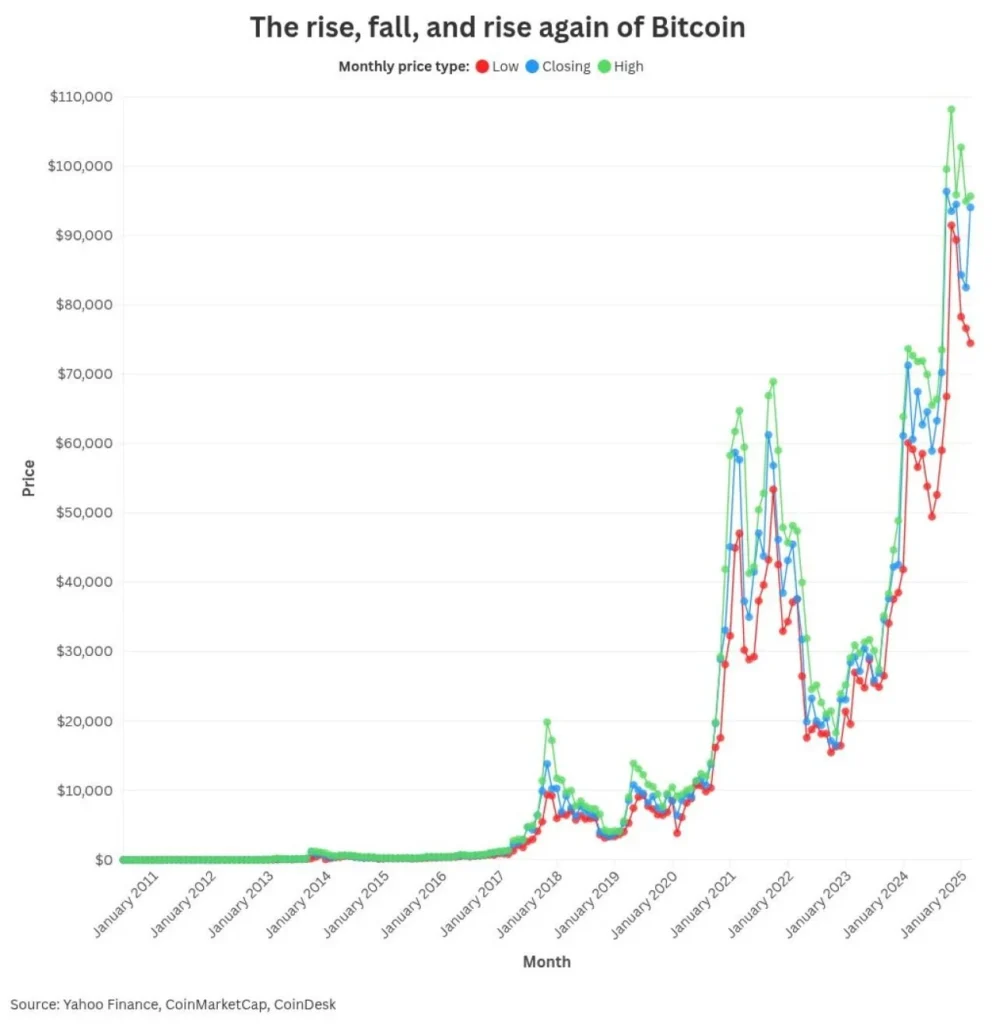Bitcoin’s price surge is simply staggering. From worthless in 2009 to a mind-bending $110,000 in 2025, this digital currency has shattered every expectation. Daily swings remain modest at 1%, but zoom out and the gains are astronomical – we’re talking 1,075% over five years. While whales control most of the supply, institutional investors have helped stabilize the wild ride. Current predictions suggest $126,200 by June, but Bitcoin’s full story goes much deeper.

The meteoric rise of Bitcoin has been nothing short of mind-boggling. From its humble beginnings near zero dollars in 2009, the cryptocurrency has skyrocketed to astronomical heights.
From zero to hero: Bitcoin’s astronomical climb since 2009 has transformed digital money into a financial force of nature.
By 2011, it hit $30,000. Then boom – $60,000 in early 2025. And just when skeptics thought it couldn’t go higher, Bitcoin smashed through $110,000 in May 2025. Talk about a wild ride.
These days, Bitcoin trades between $107,000 and $110,000, showing signs of relative stability – well, as stable as Bitcoin gets. The fact that 2% of whale accounts control most of Bitcoin’s supply adds another layer of volatility to the market.
Daily price swings are modest, often less than 1%. Weekly and monthly trends paint a rosier picture, with gains like +5.07% over seven days and +1.51% over thirty days. Not too shabby for what started as magic internet money. The security of transactions is maintained through cryptographic verification by miners solving complex mathematical problems.
The long-term numbers are enough to make traditional investors weep. Five-year returns? Over 1,075%. The historic first Bitcoin trade in 2009 had virtually no value, with early users exchanging it purely for curiosity.
Seven years? Try +1,726%. And let’s not forget those insane years – 2013 saw gains of +5,189%, while 2017 delivered +1,162%. Even 2020’s +270% looks pedestrian in comparison.
Looking ahead, analysts expect Bitcoin to keep climbing through 2025, potentially reaching $126,200 by late June.

The crystal ball gets murkier after that, with predictions ranging from $102,507 to $137,041 between July and September. Market sentiment sits at a cautiously optimistic 60%, though the Fear & Greed Index occasionally hits rock bottom.
History shows that Bitcoin’s price movements aren’t random chaos. Major bull runs follow predictable patterns, often triggered by halving events every four years.
Global regulations, adoption trends, and economic factors all play their parts. Institutional investors have helped stabilize prices since 2020, but let’s be real – Bitcoin still has its moments of pure mayhem.
Bitcoin’s decade-plus journey from penny stock territory to six figures proves one thing: this digital asset isn’t just surviving, it’s thriving.
Whether you love it or hate it, Bitcoin’s price trends have permanently altered the financial landscape.
Frequently Asked Questions
How Do Government Regulations Impact Bitcoin’s Long-Term Price Stability?
Government regulations serve as a double-edged sword for Bitcoin’s price stability.
Clear frameworks boost investor confidence and market legitimacy, attracting institutional money.
But heavy-handed rules can squash trading and jack up compliance costs.
Japan’s welcoming stance sparked price jumps, while China’s crackdowns triggered drops.
The reality? Bitcoin’s decentralized nature means local regulations only go so far.
Global coordination is needed for lasting impact.
What Role Do Institutional Investors Play in Bitcoin Price Movements?
Institutional investors massively influence Bitcoin prices through their huge capital injections and long-term holding patterns.
When giants like MicroStrategy gobble up over 1% of total Bitcoin supply, prices surge. These big players also lend legitimacy to crypto markets – their presence alone attracts more investors.
But it’s not all rosy. Their concentrated holdings can trigger sharp selloffs, and their correlation with traditional markets actually increases Bitcoin’s vulnerability to broader economic shifts.
Can Bitcoin Mining Difficulty Affect Its Market Price?
Mining difficulty and price have a complex relationship.
When prices surge, more miners jump in – pushing difficulty higher. But it’s not always that simple.
Higher difficulty means higher production costs, which can support price levels as miners won’t sell below cost.
Sometimes difficulty keeps climbing even when prices drop. It’s a feedback loop, but external factors like Fed decisions often mess with the pattern.
How Do Global Economic Crises Influence Bitcoin Price Volatility?
Global economic crises trigger extreme Bitcoin price swings.
Market panic during banking failures, inflation spikes, or currency devaluation often sends investors scrambling toward Bitcoin as a perceived safe haven.
But it’s a wild ride.
While some crises boost Bitcoin’s value through increased demand, others spark massive selloffs.
Regulatory responses to economic turmoil can make things even crazier, amplifying Bitcoin’s already notorious volatility.
What Impact Does Bitcoin Halving Have on Its Market Value?
Bitcoin halving slashes mining rewards in half, creating a supply shock that historically correlates with price increases.
Each halving event has preceded significant bull runs – though not immediately. Markets take time to digest the reduced supply.
It’s simple math: fewer new bitcoins hitting exchanges while demand stays steady or grows.
Past halvings triggered epic rallies, but there’s no guarantee history repeats itself.
